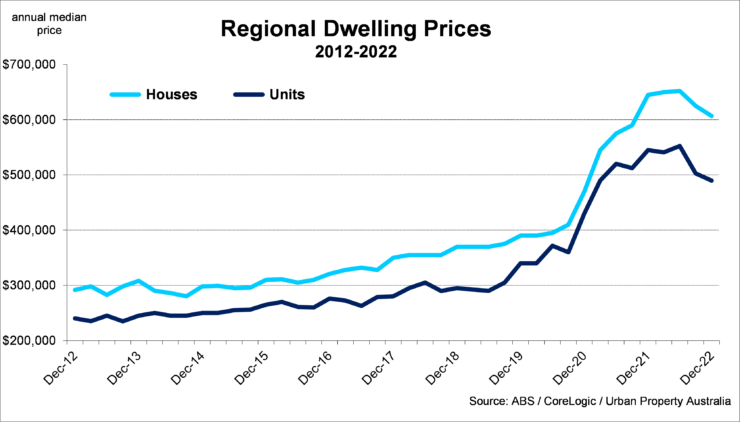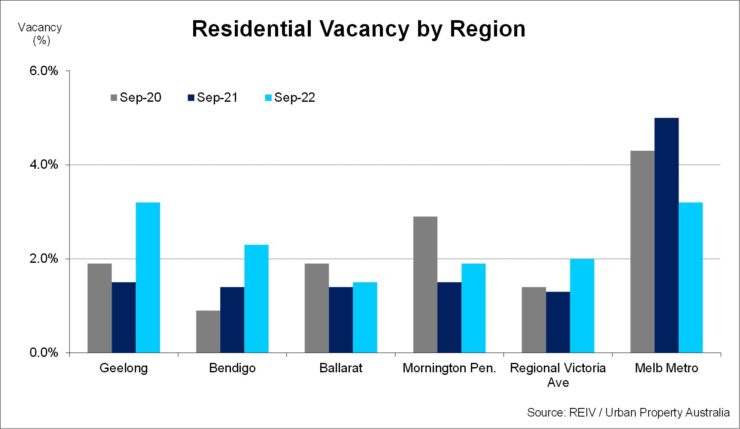Q4 2022 – Victorian Regional Residential Market
February 10th 2023 | , Urban Property Australia
- Both Victorian Regional house and unit prices declined over the December 2022 quarter and are both now below levels recorded a year earlier;
- The vacancy rate for Regional Victoria remains very tight at 1.9%, led by Ballarat (1.3%) and Bendigo at 1.5%;
- Regional Victorian weekly rental levels for both houses and units have risen to all-time highs as at December 2022, having increased by 10% and 6% over the year respectively.
Victorian Regional Residential Market Summary
Although prices have not fallen to the extent of those in the Melbourne metropolitan area, Victorian Regional housing prices have declined for two consecutive quarters for the first time since 2014. With demand surpassing availability, the vacancy rate for Regional Victoria remains very tight at 1.9% with the residential vacancy rate of Ballarat even lower at 1.3%.
Prices
Although prices have not fallen to the extent of those in the Melbourne metropolitan area, Victorian Regional housing prices have declined for two consecutive quarters for the first time since 2014. Victorian Regional house prices fell by 3% over the December 2022 quarter to now sit at $606,000 and 6% below the levels observed 12 months ago. Median Regional unit prices have decreased by even more over 2022, falling by 10% to $489,000 back to levels achieved in March 2021. According to the REIV, median house prices of the regional cities of Ballarat ($5850,000) and Bendigo ($580,000) both reached all-time highs as at December 2022 for the third consecutive year however Geelong median house prices declined over the December 2022 quarter to $780,000. While there is some downside risk to median dwelling prices for Victorian regional properties, given the relative affordability compared to metropolitan properties, Urban Property Australia expects that the Regional housing markets will outperform the metropolitan housing market in the short term.

Demand / Vacancy
According to the ABS, Melbourne metropolitan’s population declined by 60,500 over the year to June 2021 with 33,500 Melburnians moving to the regions. Geelong and Ballarat experienced the biggest gain in population which has also led to employment growth. The pandemic and working from home has made a regional move more possible for those in capital city-based jobs, with the flexibility of work never been so recognised as previously considered.
According to the REIV, as at December 2022, the vacancy rate for Regional Victoria remains very tight at 1.9% (albeit higher than the rate of 1.3% recorded a year earlier) in comparison to the metropolitan average of 2.5%. The vacancy rates of the major Regional Cities also remain very low, led by Ballarat (1.3%) followed by Bendigo at 1.5% and Geelong (3.1%).

Rents
Similar to dwelling values, housing rental levels in the Regional markets have continued to increase across most regions. According to the REIV, Regional Victorian weekly rental levels for both houses and units have risen to all-time highs. Over the year to December 2022, the weekly median rent for houses in Regional Victorian rose to $440 per week, up from $400 per week a year earlier. Likewise, the weekly median rent for units rose to $370 per week, up from $350 per week a year earlier. By regional city, Ballarat outperformed both Geelong and Bendigo with the weekly median rent for houses up 8.6% to $380 as at December 2022. In comparison weekly median rents for houses in Geelong increased by 6.7% to $480 with rents for Bendigo houses increasing by 5% to $430 per week as at December 2022.
Copyright © 2023 by Urban Property Australia All rights reserved. No part of this publication may be reproduced in any form, by microfilm, xerography, electronically or otherwise, or incorporated into any information retrieval system, without the written permission of the copyright owner.



